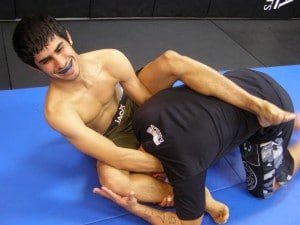Stephan’s Note: This article is by Grapplearts correspondent Bryanna Fissori, who has previously contributed a piece about MMA training at John Hackleman’s Pit, the home school of former UFC Champion Chuck Liddell.
In the midst of the rising popularity of Mixed Martial Arts with mainstream viewers has come a surge in a new kind of martial artist: the self-taught via television screen and computer monitor.
Mixed Martial Arts (MMA) began to rise in popularity during the early 1990’s, but due to lack of regulations including weight classes and rules in the cage, it was less popular with average viewer and considered by many to be human cock fighting. That image began to evolve over the next decade or so with implantation of the Unified Rules of Mixed Martial Arts, creating less of the violent blood-bath many would-be viewers avoided.
Today MMA widely accepted as a sport made up of numerous components extracted from a plethora of disciplines. Most practitioners of the game undergo training in a gym or dojo either specific to a single disciple or combined as an “MMA gym.” Either way, typical training across the board consists of cardio, strength, conditioning and of course technique. But today gyms are beginning to see an increasing number of students coming in to the sport with a background in “video martial arts.”
The increase in MMA’s popularity has triggered a boost in interest for many specific disciplines with some of the major players being Jiu Jitsu, Muay Thai and Karate, but instead of heading straight to the dojo some students are finding technique in the comfort of their own homes.
Youtube
Richard Bown Jr. trains at The Arena MMA in San Diego, California where he is endearingly referred to by his teammates as “Chavez” a nickname he was given by a teammate. His interest in training was sparked like that of many others. “I would watch it on T.V. and record anything U.F.C., W.E.C. or MMA related,” said Chavez. “In the beginning, for the first six months to a year the only training I got was on my own. I got started because I use to play a lot of sports, but I was too small to play in college. With combat sports it’s different because you can find people your size.”
Being from the small town of Calexico, California Chavez did not have many options for training, so he resorted to other methods. “I watched a lot of Youtube,” said Chavez. “I would type in G.S.P. training and would watch how G.S.P. trains, or what someone like Freddie Roach is teaching. I would find out what the best people were doing for workout and I would do what they were doing.”
To practice the moves Chavez would borrow workout mats from the school where his father was a teacher. “They were the little yoga workout mats and I would have to tape them together on the bottom so they wouldn’t come apart. Then I would invite friends over and whoever wanted to come would come.”
 Two years into training Chavez (shirtless in the photo) has competed in two Jiu Jitsu competitions and one amateur MMA bout. One of his favorite moves learned from Youtube is the Peruvian Necktie, which most Jiu Jitsu practitioners will contend is a difficult move to master from a hands-on instructor, let alone a computer screen.
Two years into training Chavez (shirtless in the photo) has competed in two Jiu Jitsu competitions and one amateur MMA bout. One of his favorite moves learned from Youtube is the Peruvian Necktie, which most Jiu Jitsu practitioners will contend is a difficult move to master from a hands-on instructor, let alone a computer screen.
Jai Troche trains at No Remorse in Honolulu, Hawaii. Despite being only 17, Jai has a wealth of martial arts knowledge well beyond his years, most of which has come from hands-on instruction, but has been complemented by external sources. He has nearly 20 fights/matches already under his belt.
“The Eddie Bravo stuff is pretty slick,” said Jai. “But if you have him as a coach you I’m pretty sure you would be able to do it a lot more successfully. There are certain techniques that work and certain techniques that don’t work for your own personal body type.”
So yes, fighters can and do supplement their training with techniques learned from Youtube, and so can you. But now let’s look at an even more unlikely source of technical instruction…
Video Games
In addition to Youtube, student are also tightening up their skills via Xbox and Playstation. The UFC and E.A. Sports both have well-developed MMA video games which encompass virtually all the details you would find in a real bout. Players who have never touched foot a mat learn how to take down and past the guard to set up for the submission.
“One of the best things I learned from the UFC video game (UFC Undisputed) was the importance of distance,” said Chavez. “Throwing some punches and circling out.”
E.A. Sports Game Designer Victor Lugo shared the same sentiment in an exclusive interview with GrappleArts.com, “One of the things that is really stressed is the importance of circling.” said Lugo. “In the game if you circle into the opponent’s strong side you are going to be significantly more damaged than if you had circled away.”
Lugo explained that he and a number of the other designers for the game were brought on the team because of their background in specific martial arts disciplines. “We are able to capture how a fighter actually trains,” said Lugo, “Because so many of us train we can take the player through that process. There are real drills and real combinations that players have to work on to prepare for the fight in the game. It gives anyone starting in the sport a good idea of what to really expect when they get to the gym.”
Even though the work is being done through the push of a button, those buttons still force players to have knowledge of what will work situational. If one player shoots in, the other has to know how to sprawl. If a player gets mounted on the ground he needs to know the escape. To be successful in the game, players have to have a general knowledge of the techniques. They may not be developing muscle memory, but they are developing a mind set.
After the release of the UFC game Undisputed 2010 Producer Neven Dravinski stated in an interview with Game Focus, “Each match has this inherent tension to it. When you watch two really skilled jiu-jitsu fighters go at it, you can always see that attempt to gain position. . . When you see two people playing who really know the game, it’s scary how much like a real fight it looks like. There’s a really cool cat and mouse game going on that is really indicative of the tension and strategy in a real fight.”
Jai considers the best move he picked up from a game to be the rolling arm bar from back mount. “I thought it was a cool move.”
“The video games are really realistic these days,” said Jai. “So it teaches you decent technique. Not really great, but it’s a way to get knowledge of a position.”
 About the Author: Grapplearts.com correspondent Bryanna Fissori is the 135lb belt title holder for Fight Girls, Hawaii and also has a successful track record in BJJ and submission grappling competition. She trains at South Oahu MMA and Relson Gracie Waterfront Jiu Jitsu in Honolulu, Hawaii, and has been known to supplement her training with techniques she’s learned online.
About the Author: Grapplearts.com correspondent Bryanna Fissori is the 135lb belt title holder for Fight Girls, Hawaii and also has a successful track record in BJJ and submission grappling competition. She trains at South Oahu MMA and Relson Gracie Waterfront Jiu Jitsu in Honolulu, Hawaii, and has been known to supplement her training with techniques she’s learned online.
IF YOU LIKED THIS ARTICLE YOU MIGHT ALSO LIKE STEPHAN KESTING’S INTERVIEW WITH MARSHALL CARPENTER FROM LOCKFLOW.COM: “LEARNING BJJ IN A DIGITAL AGE“
The post Can You Actually Learn to Grapple from Youtube and Video Games? appeared first on Grapplearts.
